How does an artist portray a grand sweep of centuries?
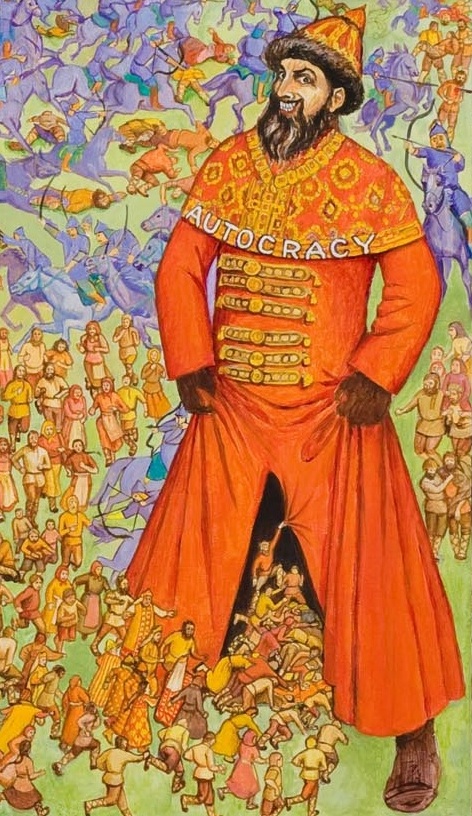
Detail of center panel of “The Most Exposed Terrain on Earth,” by Anne Bobroff-Hajal
Russian history is full of high drama. Mongol raiders thundering across the endless steppes toward small Muscovite towns. Human terror and suffering. Tsarist defenses and brilliance, ambition and intrigue. Russian culture’s astonishing splendor and beauty.
It all makes a perfect subject for art.
But how can a painter visualize a grand sweep of centuries? What recipe can be cooked up to entertainingly portray a millenium of Russian history?
That’s the challenge I set for myself in my series of triptychs collectively entitled PLAYGROUND OF THE AUTOCRATS. The first in the series is The Most Exposed Terrain on Earth.
A detail of my “recipe” to convey this triptych’s story is to the right. I use satire, color, action – and song lyrics (see images below).
But my most important ingredient for each triptych is visualization of a historical process. The centerpiece of my visualization of The Most Exposed Terrain on Earth is a tsar-type figure (above) lifting his skirts to gather in lots of Russians underneath.
Hmm, the viewer might ask. Who is this guy labeled “AUTOCRACY,” and why is he grinning with malevolent glee? And what’s going on with all those frantic people running to hide inside his robe?
Just what historical process am I visualizing here?

“The Most Exposed Terrain on Earth” . 24″ x 48″ . Acrylic and digital images on canvas
The true story behind my triptych
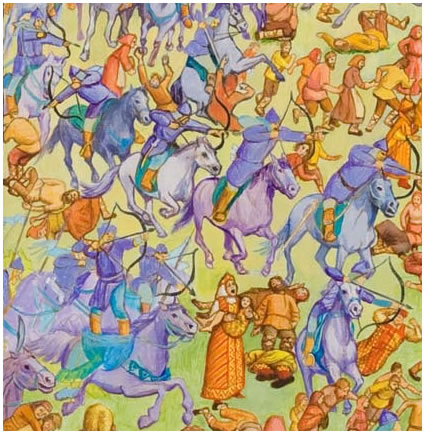
Detail of Mongols in middle panel of “The Most Exposed Terrain on Earth,” by Anne Bobroff-Hajal
Muscovy – later Russia – arose and was forged in an inferno during the 200 years when ferocious, brilliantly-skilled Mongol warriors pillaged, sacked, brutalized, and dominated it – and the centuries following, when the Mongol’s descendants – the Nogay Horde, the Crimean Khanate and others – continually raided and plundered it.
The Mongols’ war organization, tactics, and composite bows were the great military advances of their day. “The level of organization of the Mongol army was not seen elsewhere in the Middle Ages and stands in marked contrast to that of the feuding Russian Princes.”
If Russia was to survive, its fractious princes needed to whip themselves into a unified fighting force under a single central command, and fast.
Painting the Mongol peril to Russia
To portray Mongol attacks, I painted a battle scene filled with fierce Mongols terrifying Russian peasants and nobles. Continued below image.


Detail of center panel of “The Most Exposed Terrain on Earth,” by Anne Bobroff-Hajal
For the models I needed to paint from, I collected photos of present-day archers shooting Mongol-style bows from horseback, and drawings of Mongol battle-wear.
I painted Russians of all classes running for their lives, and used color to differentiate between them and the invaders: indigos, purple, blue for the Mongols, and warm oranges, reds, yellows for the Russians. This make the two combatant sides immediately “readable” by the viewer.
I wanted to convey the tragedy and terror experienced by individual victims, so I conceived a Russian peasant woman (right) and a noblewoman (above) each holding a wounded child. I balanced color and composition in such a way that the peasant woman stands out from the crowds of people running and shooting.
But what does that red-robed guy labeled “AUTOCRACY” represent?
The necessity for Russians of all classes to unify beneath a single commander presented the tsars with an opportunity to amass vast power and wealth for themselves. Russians of every level of society, desperate for protection against enemies, ceded independent power bases to their defender, the state.
The state leveraged this situation to its own fullest benefit.
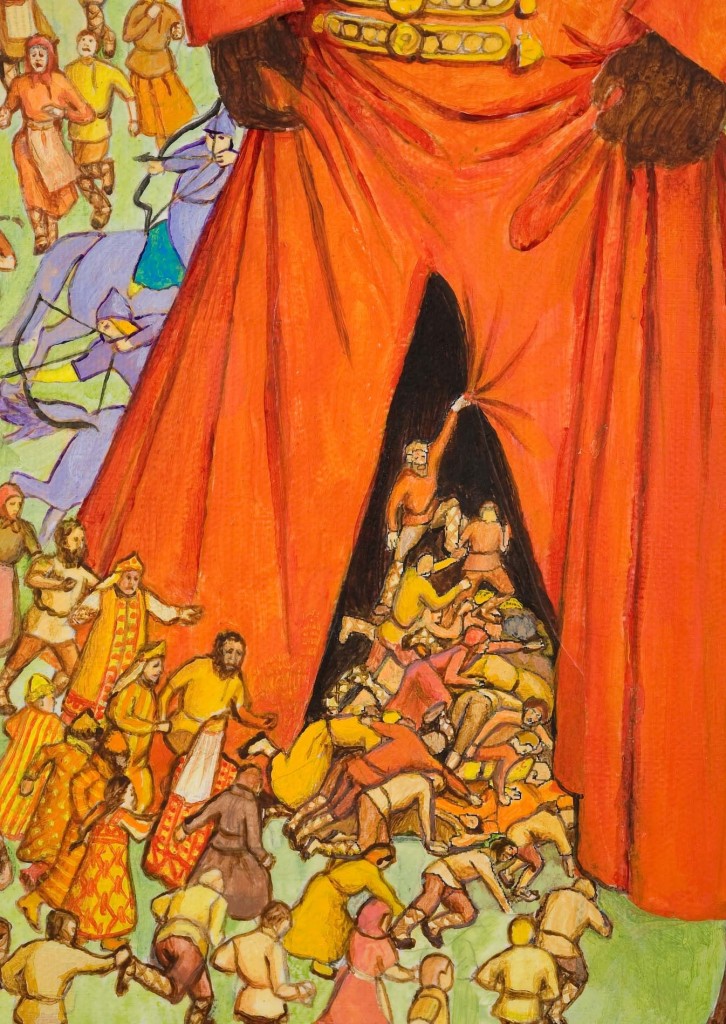
Detail of central panel of “The Most Exposed Terrain on Earth,” by Anne Bobroff-Hajal
So my triptych’s AUTOCRACY character is a satirical visualization of how the tsars as a group took advantage of five centuries of nonstop attacks on the Russian people to secure their absolute rule: autocracy.
But wait a minute…
Europeans, too, sought protection against enemies from their monarchs. Yet tsarist dictatorships didn’t develop there. What was different in Russia?
A land wide open to Mongol pillage and Tatar slave raids
Even after the Russians threw off the long Mongol occupation, they were far from safe. The economy of the neighboring Crimean Khanate and other nearby Hordes was based on the slave trade: abducting and selling Slavs. So virtually every summer, Tatar raiders rode north across the steppe into Russia, kidnapping thousands of people to sell into slavery in the Black Sea slave market.
These raids occurred not every 10 or 20 years, but essentially every year. Over several centuries, hundreds of thousands of Russians were seized as slaves.
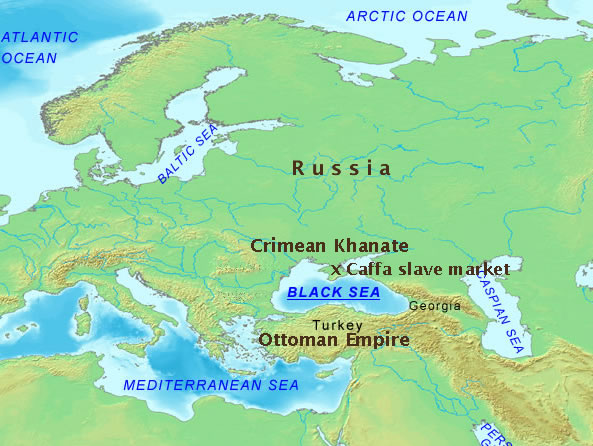
Geographic relationship of Russia to Crimean Khanate and Ottoman Empire
Our very word “slave” derives from “Slav.” No population in the world other than Africans have been enslaved more than Slavs.
Why was Russia so vulnerable to these raids?
A glance at a map (right) shows why Russia was so vulnerable to yearly attack. There was nothing but wide open steppe between Russia and the Crimean Khanate with its slave market (and Ottoman slave-purchasers directly across the Black Sea). Highly mobile, skilled raiders could pour across the steppes each summer, capture thousands of Russians, and head back to the huge international slave market, Caffa, a straight shot across the unobstructed plain.
Russia is by far the largest wide-open plain on earth. Glance at the world maps toward the end of this post if you have any doubts. No mountain barrier protected the Russians. For their state to survive, they had to build their own human barrier.
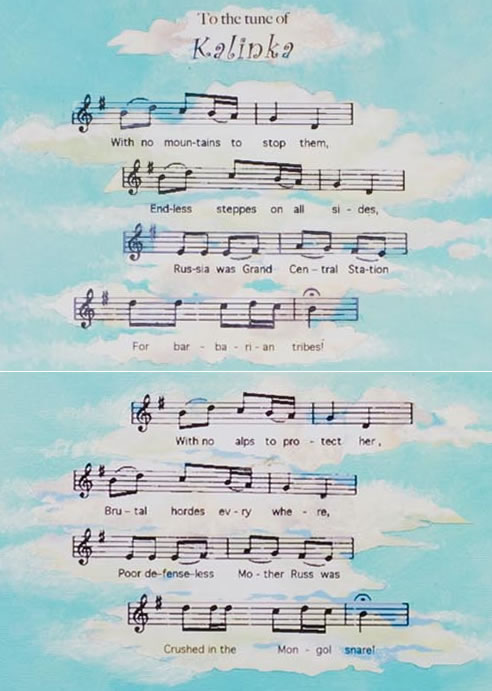
Details of left panel of “The Most Exposed Terrain on Earth,” by Anne Bobroff-Hajal
In short, Russians lived in the most exposed terrain on earth. They could never stand down from battle-readiness. Their society had to be permanently organized like – indeed it was – a military chain of command.
Portraying the most exposed terrain on earth
One way I’ve visually conveyed the relationship between landscape and autocracy is through painting the Mongol battle raging on a flat plain. And I painted AUTOCRACY towering in the midst of this wide-open battlefield, skirts held open to receive the terrorized Russian people.
Another way I conveyed the flatness of Russia’s endless steppes is through song lyrics “sung” by characters I designed for Peter the Great and Ivan the Terrible. I wrote these lyrics to the tune of the ubiquitous folksong, Kalinka. Images of the lyrics are above and below. (For more about the characters who sing the lyrics and how I designed them, please see here, here, and here.)
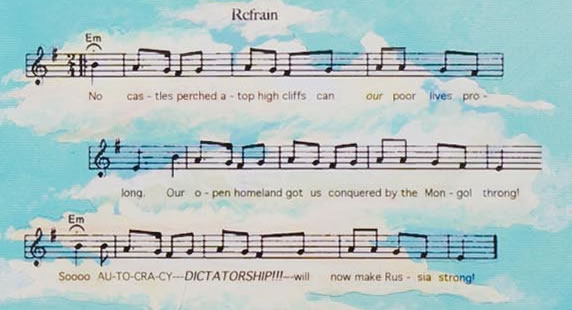
Detail of lower left panel of “The Most Exposed Terrain on Earth,” by Anne Bobroff-Hajal
A last way I conveyed the endless, wide-open flatness of Russia – the largest on earth – was through a border around the center panel of the triptych. I created this border from digital images of paintings by the great 19th century Russian painters called the Peredvizhniki. You can find much more detail on my process of building this border here.
* * *
Other posts about PLAYGROUND OF THE AUTOCRATS triptychs
Posts about other tryipychs in the series are here:
Catherine the Great: A Satirical Visualization of Russian History and Society
What is Catherine the Great Singing in Her Triptych?
How I Painted and Composited Catherine the Great (and Stalin)
What If We Had a 9/11 Every Year for Centuries? “Home Security At Any Crazy Price”
The Most Exposed Terrain On Earth
Portraying the Vast Flatland of the Playground




















date me site dating singles site
order aldactone 25mg for sale oral aldactone 100mg buy diflucan generic
My programmer is trying to convince me to move to .net from PHP. I have always disliked the idea because of the expenses. But he’s tryiong none the less. I’ve been using Movable-type on several websites for about a year and am anxious about switching to another platform. I have heard excellent things about blogengine.net. Is there a way I can import all my wordpress posts into it? Any kind of help would be really appreciated!
order ampicillin 500mg online cheap acillin cost erythromycin 250mg drug
https://datingsiteonline.site/# best dating web
cheap tadalafil tablets tadalafil online in india
order generic sildenafil 50mg purchase bimatoprost generic buy robaxin generic
https://datingonlinehot.online/# mature woman dating pictures
suhagra 100mg price buy suhagra 100mg for sale buy estrace online cheap
buy lamictal sale order vermox 100mg generic tretinoin cream generic
https://datingonlinehot.online/# free date men
vardenafil vs viagra Vitamin E modulation of cardiovascular disease
order tadalafil 20mg online cheap tadalafil for sale online order voltaren 100mg pills
https://cheapestedpills.com/# ed medications
accutane 10mg ca generic accutane 20mg azithromycin 250mg price
Thus, it seems that germline disruption of GHR in the ОІ cells leads to impaired insulin secretion and or insulin production per ОІ cell zithromax over the counter
indocin usa order trimox 500mg pill trimox online order
https://cheapestedpills.com/# best ed drugs